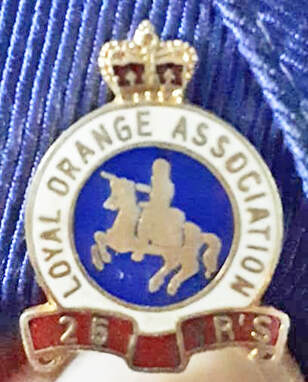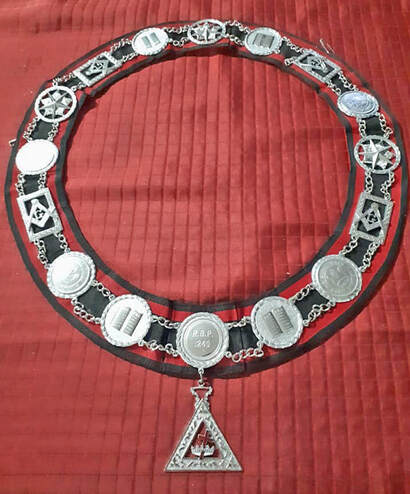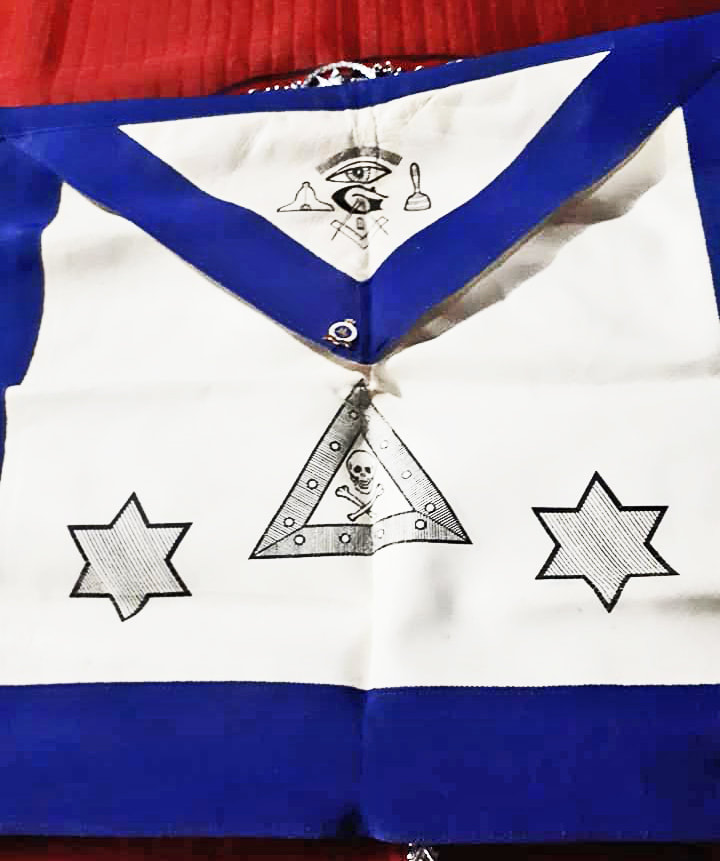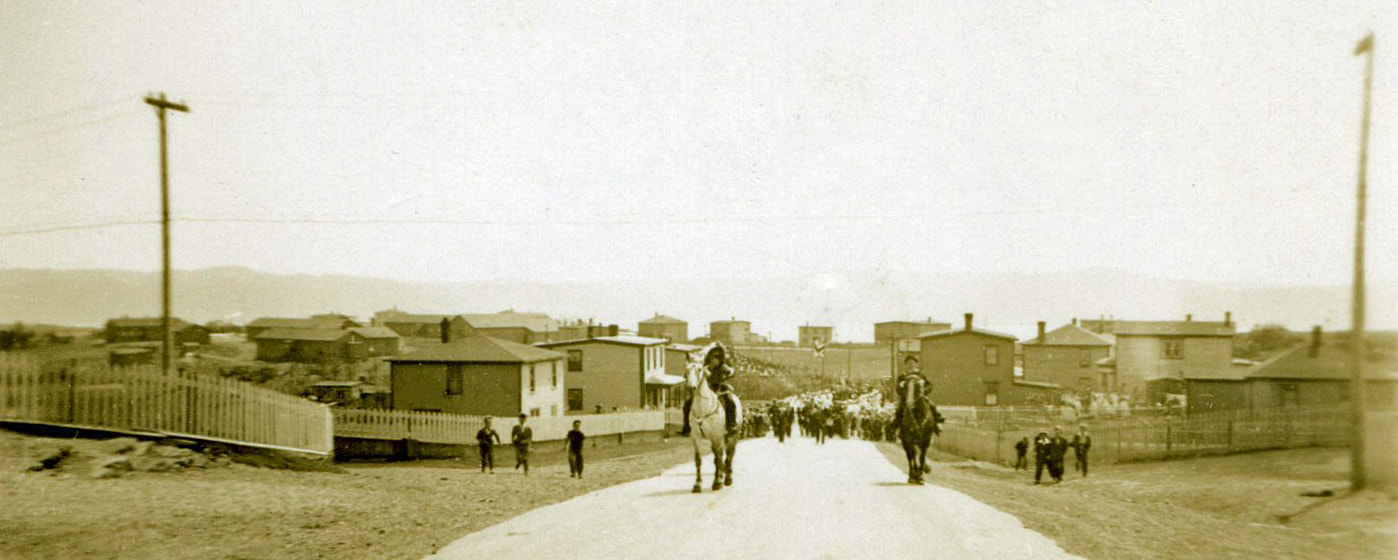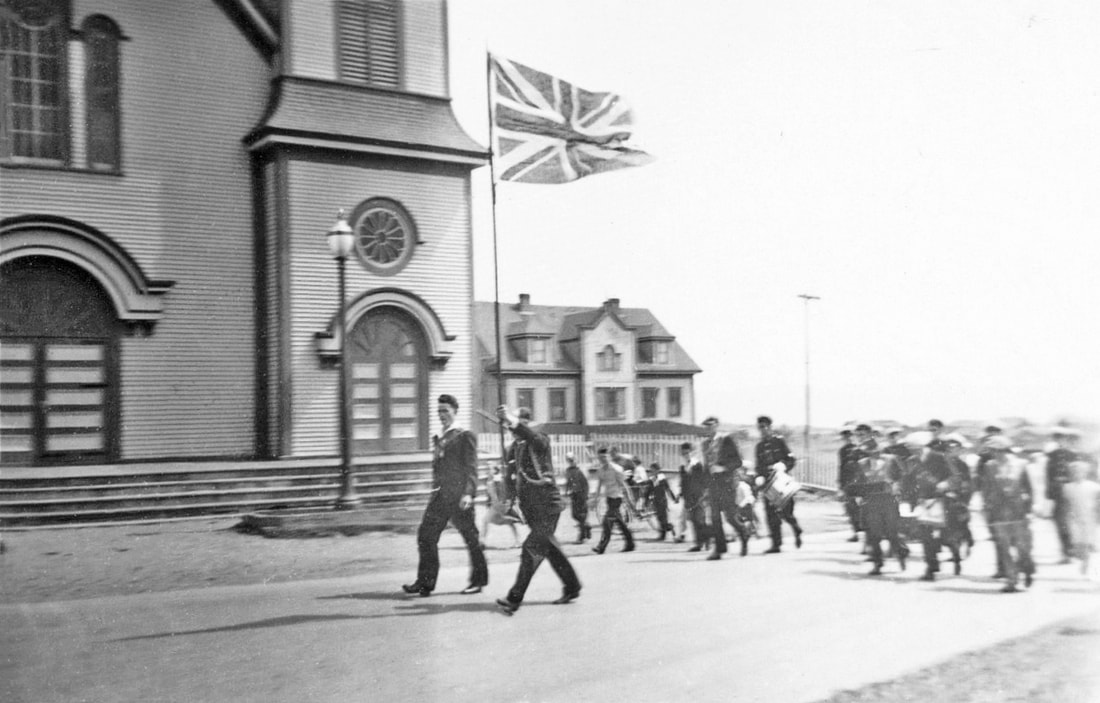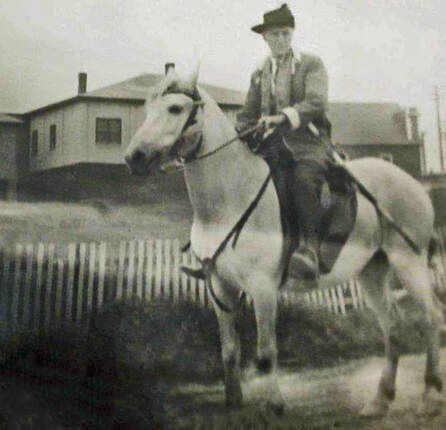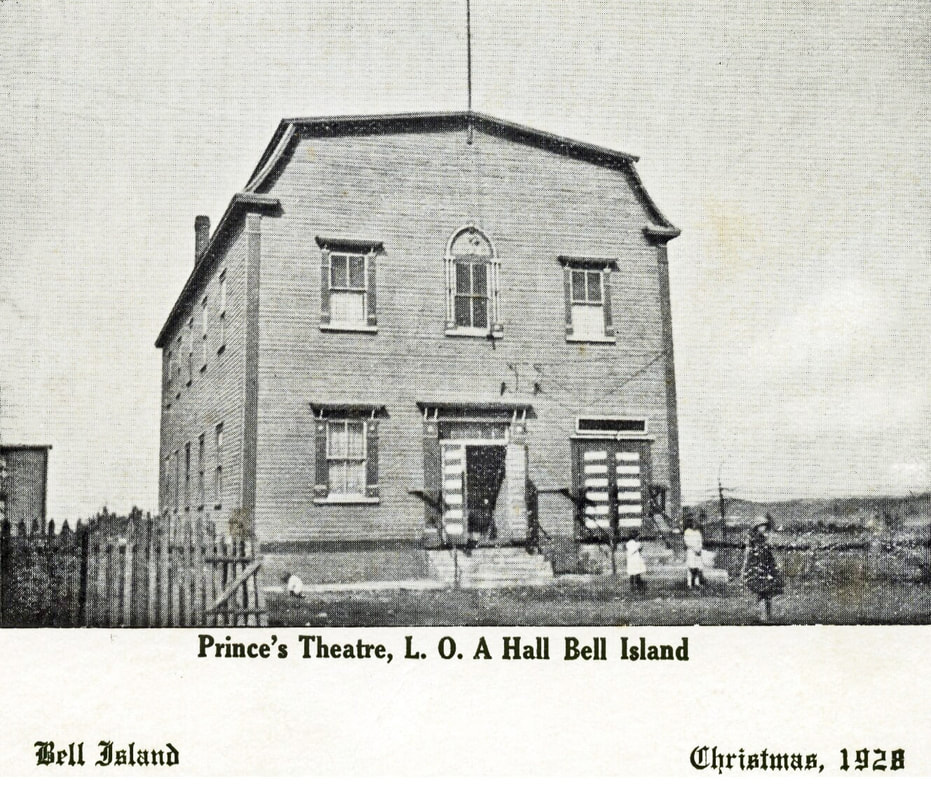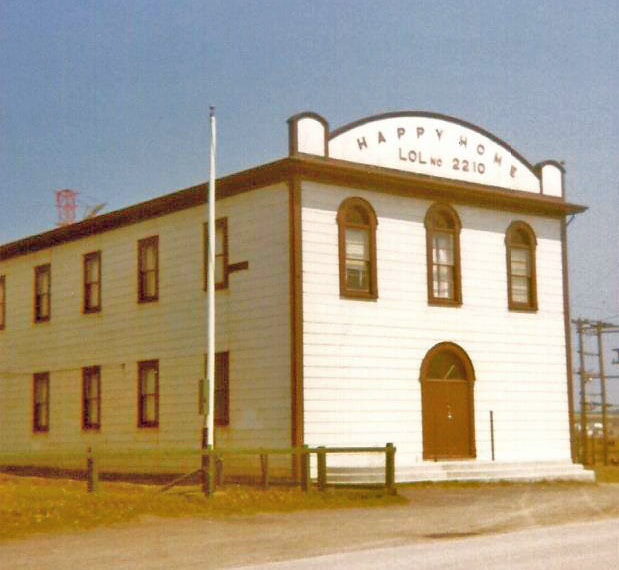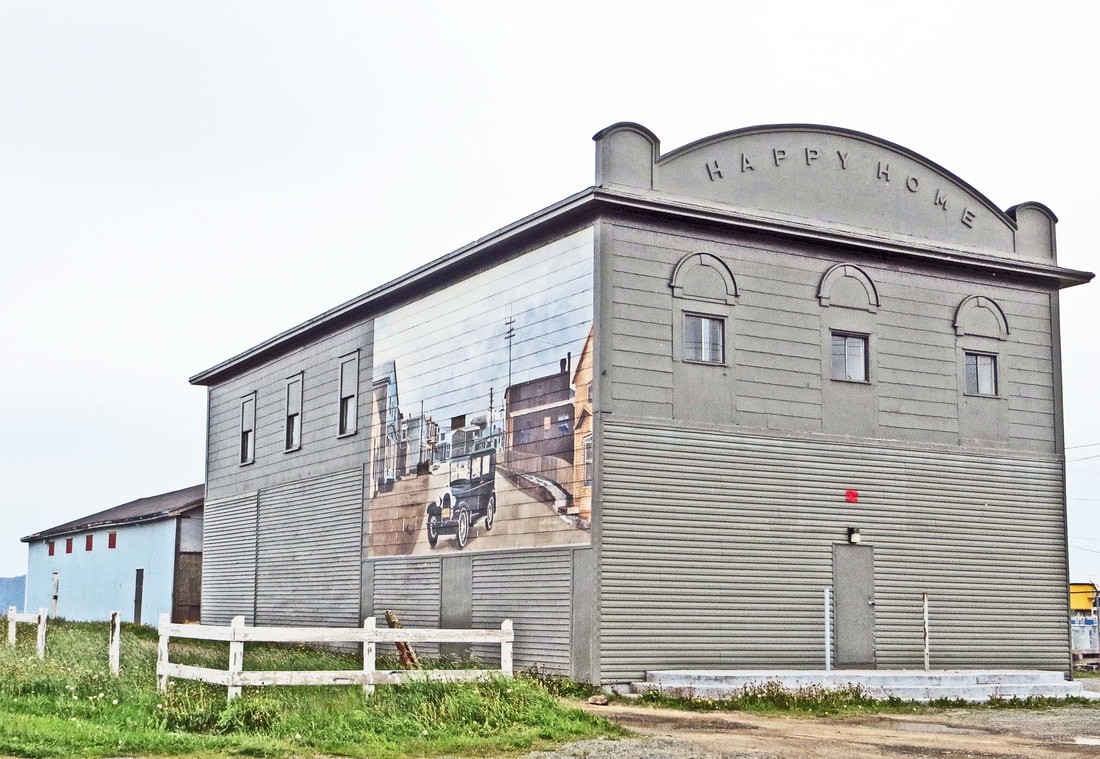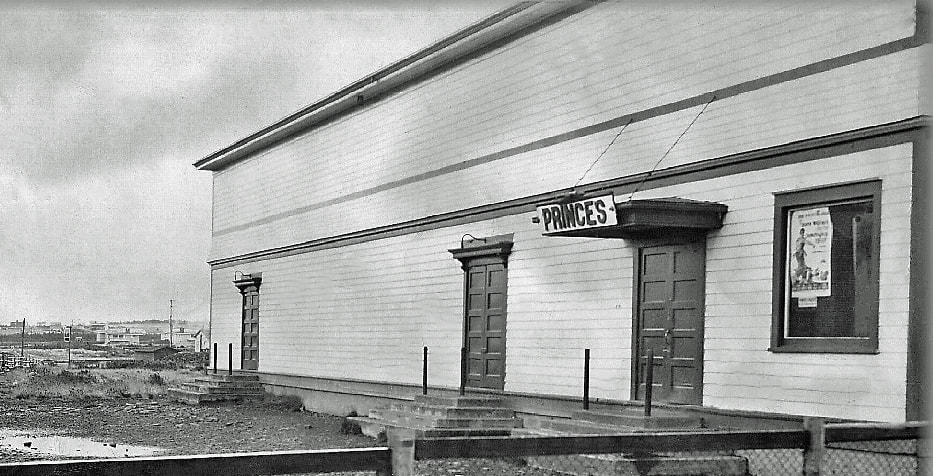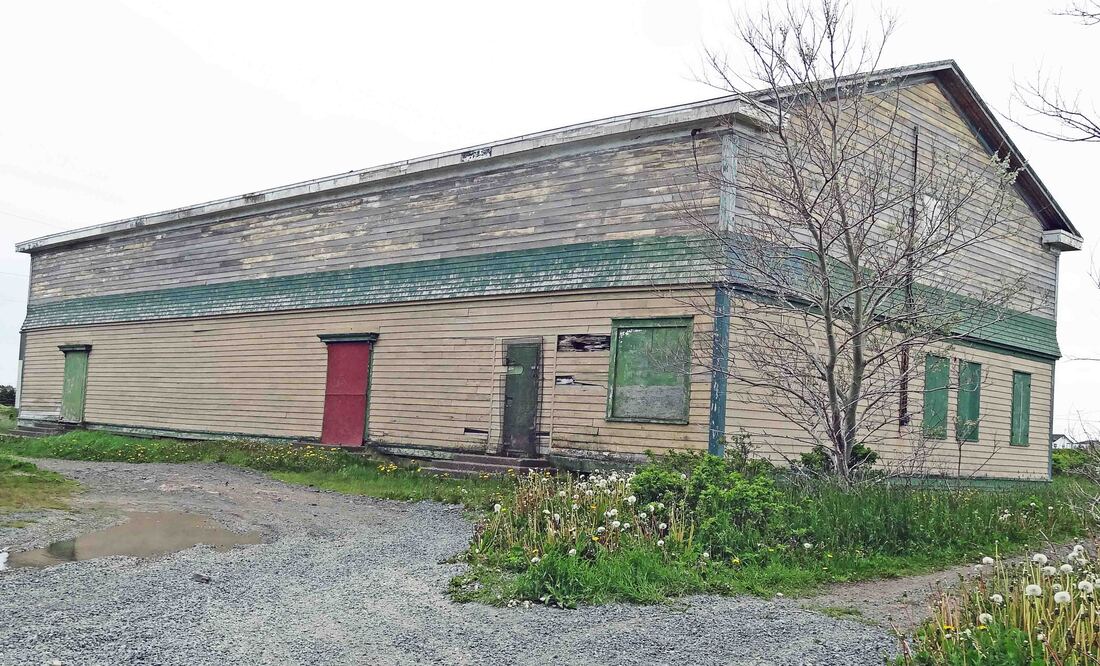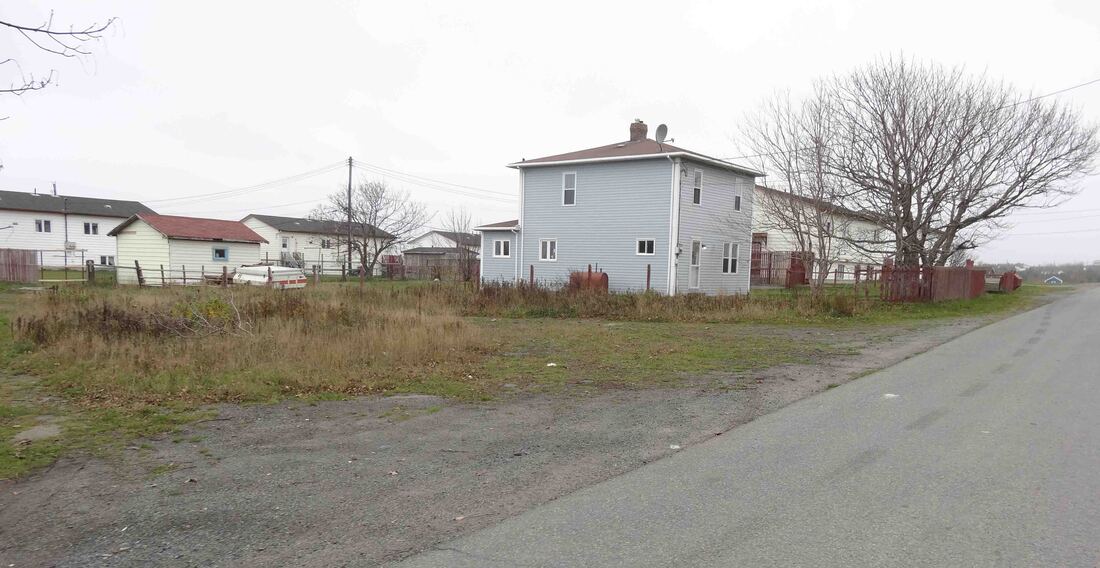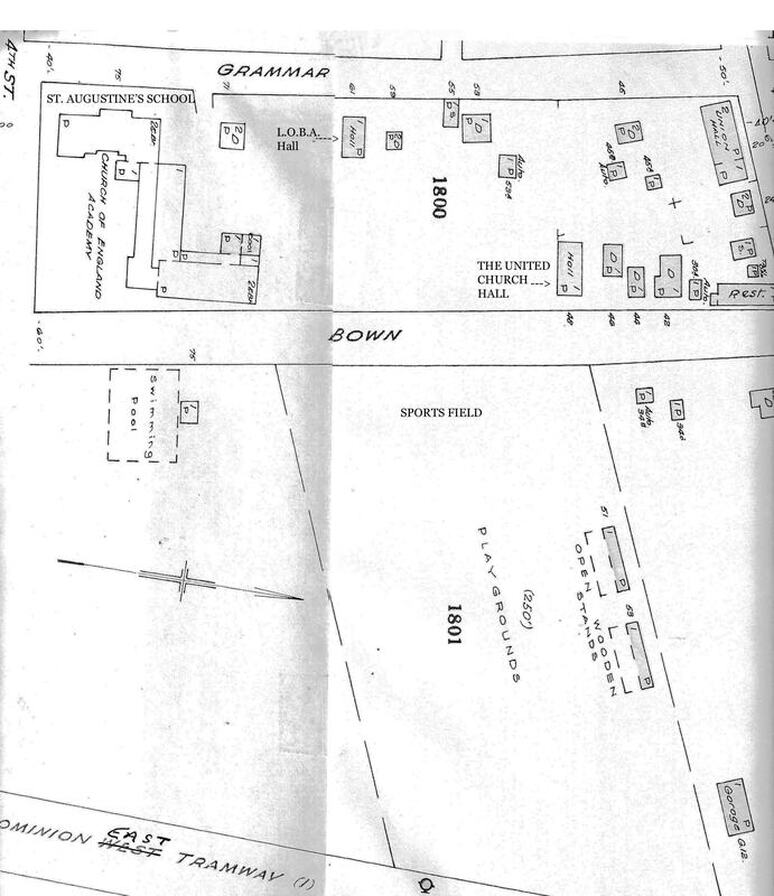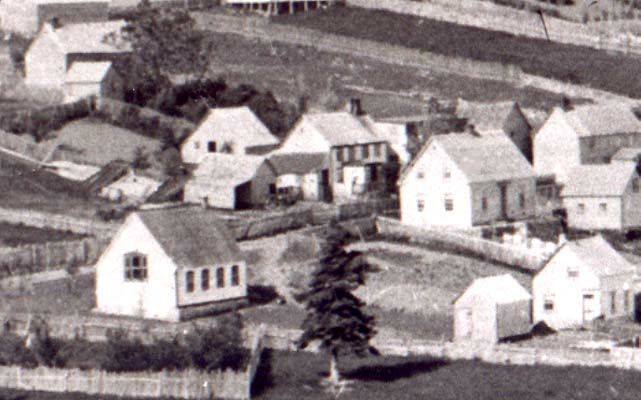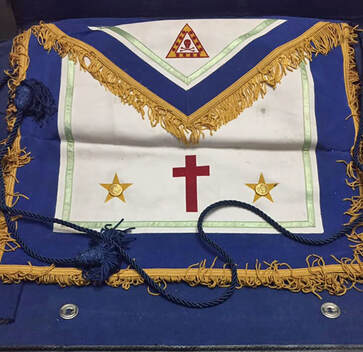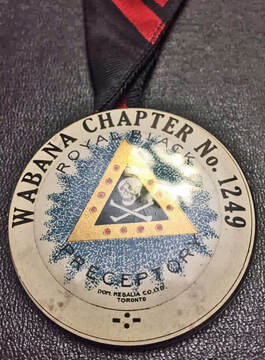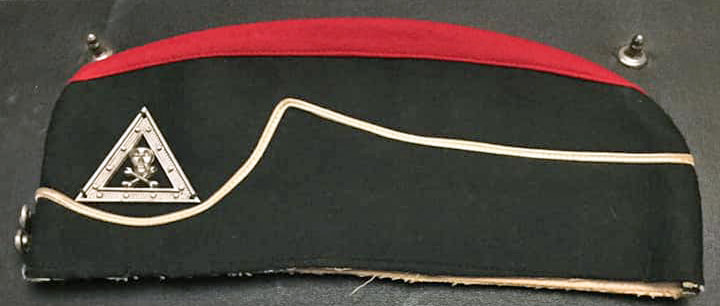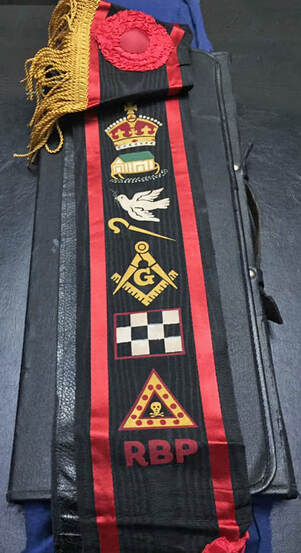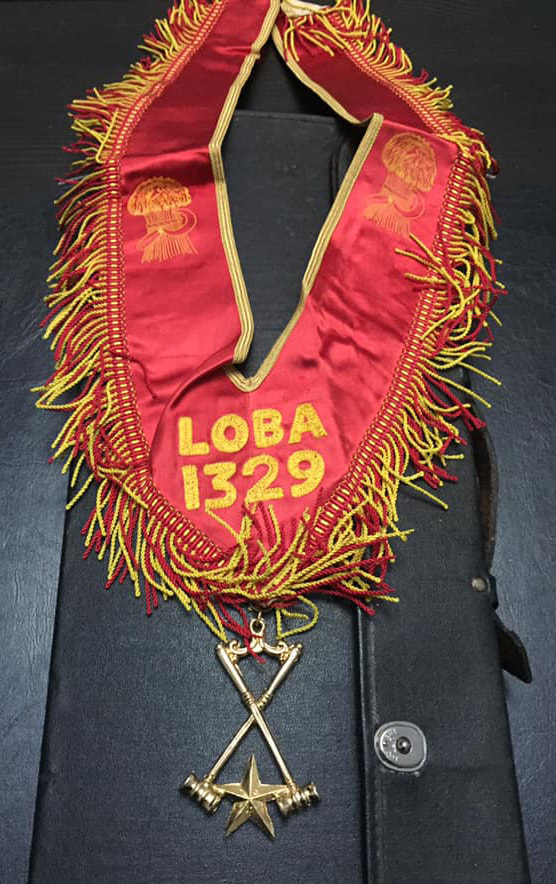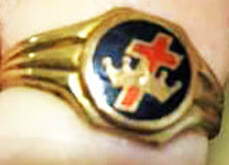HISTORY
COMMUNITY ORGANIZATIONS
COMMUNITY ORGANIZATIONS
LOYAL ORANGE ASSOCIATION (L.O.A.)
&
LADIES ORANGE BENEVOLENT ASSOCIATION (L.O.B.A.)
&
ORANGE YOUNG BRITONS (O.Y.B.)
by Gail Hussey-Weir
Created July 15, 2019 / updated April 15, 2022
&
LADIES ORANGE BENEVOLENT ASSOCIATION (L.O.B.A.)
&
ORANGE YOUNG BRITONS (O.Y.B.)
by Gail Hussey-Weir
Created July 15, 2019 / updated April 15, 2022
The Loyal Orange Association pin above and the two items below belonged to Alonzo Parsons. Photos courtesy of his granddaughter Tammy Hussey Towns. The collar on the left is from the Black Lodge, aka Royal Black Preceptory, a higher order of the Orange Lodge. One must be an Orangeman to progress to the Preceptory.
Orangemen's Day is July 12th, but it is observed in Newfoundland as a provincial holiday (but not statutory) on the nearest Monday. It commemorates the Battle of the Boyne, which took place in 1690 outside Drogheda, which today is located in the Republic of Ireland. Prince William of Orange (celebrated as King Billy) won the battle against King James VII of Scotland (James II of England & Ireland). He became King William III. All that being said, the Loyal Orange Association was one of several fraternal organizations that flourished on Bell Island during the mining years. It was formed in 1910 by men of the Protestant denominations. In the early years, live theatre performances took place in its "Happy Home Lodge." In 1925, The Prince's Theatre replaced live theatre with moving pictures, which ran there until 1942, when a new Prince's Theatre building opened across the street. The association performed such benevolent work as supplying Christmas dinners to 56 families and fruit and candy to 300 poor children in 1931 during the Great Depression. It is not known when the organization disbanded, but the "Orange Hall" was last listed in the telephone directory in 1978. This was around the same time that the Salvation Army Citadel closed on Bell Island. Given the close association of these two institutions from the early 1900s onwards, it is likely that the closures were related.
The first mention of a Bell Island Orange Association parade was noted in the Daily News in 1911: "Happy Home Lodge of the Loyal Orange Association held a parade to St. Boniface Church [at The Front] on June 25 in honour of the Coronation of King George V and Queen Mary. The parade lined up 500 strong at the Salvation Army Citadel on Scotia Ridge and paraded to The Front by way of Martin's Road." In 1933 it was reported that, "The parade of the Orange societies on July 12 was marked by a record turnout. It was estimated that 400 members were in the march, and bands from Portugal Cove and Spaniard's Bay were in attendance as well as the Salvation Army Band from the Island." Many will remember the annual Orangemen's parade, which was led by "King Billy" riding a white horse. The two William Lindsay photos below are c. 1940s-50s, courtesy of A&SC, MUN Library. In these photos, the parade is moving west on Memorial Street, past St. Edward's Convent (out of the picture at the left of the first photo), and St. Michael's RC Church, in the left of the second photo, which shows the C.L.B. marching band.
The first mention of a Bell Island Orange Association parade was noted in the Daily News in 1911: "Happy Home Lodge of the Loyal Orange Association held a parade to St. Boniface Church [at The Front] on June 25 in honour of the Coronation of King George V and Queen Mary. The parade lined up 500 strong at the Salvation Army Citadel on Scotia Ridge and paraded to The Front by way of Martin's Road." In 1933 it was reported that, "The parade of the Orange societies on July 12 was marked by a record turnout. It was estimated that 400 members were in the march, and bands from Portugal Cove and Spaniard's Bay were in attendance as well as the Salvation Army Band from the Island." Many will remember the annual Orangemen's parade, which was led by "King Billy" riding a white horse. The two William Lindsay photos below are c. 1940s-50s, courtesy of A&SC, MUN Library. In these photos, the parade is moving west on Memorial Street, past St. Edward's Convent (out of the picture at the left of the first photo), and St. Michael's RC Church, in the left of the second photo, which shows the C.L.B. marching band.
History of the Loyal Orange Association, the Orange Young Britons, and the Prince's Theatre
The Loyal Orange Association No. 2210 was formed on Bell Island in 1910. Its hall, named the "Happy Home Lodge," was built on Main Street on land donated by Henry Skanes. This Lodge was also often referred to locally as "The Orange Lodge" or "The Orange Hall." (It was listed in the Telephone Directories as "Orange Hall.") On June 23, 1919, the Orange Young Britons (O.Y.B.) were organized with John Lucas as the first Master of the Lodge. They called their lodge the Prince of Wales Lodge and met at the Orange Hall on Main Street. On June 7, 1923, A.P. Cameron, former manager of the Wabana Nickel Theatre, opened a new theatre called "The People's Theatre" on the ground floor of the Orange Hall. (This was for live theatre performances.) Two years later, on October 15, 1925, The People's Theatre, which had been undergoing renovations, was reopened as The Prince's Theatre (movie theatre) under the management of members of the L.O.A. The little girls in the photo below are standing in front of the doors to the theatre which are to the right of the Hall's main entrance. The movie theatre was named for the Prince of Wales. In 1929, the Prince's Theatre, which was still located in the Orange Lodge and under the management of member W.J. Somerton, installed a second moving picture to give a continuous show. The theatre was closed on Nov. 28, 1931 in order to install talking pictures. It reopened on March 10, 1932 with sound pictures. A modern sound system was installed on January 21, 1939. The Prince's Theatre vacated the Happy Home Lodge c.1941/42 when its new building was erected across the street. The "Orange Hall" was last listed in the Telephone Directory for 1978. The building is still standing in 2021. In the 1928 photo of the Orange Hall below the Prince's Theatre was only about 3 years old. Photo courtesy of A&SC, MUN Library. See another photo from this era on the "Built Heritage" page under "Photo Gallery."
The photo below is of the same building c.1970s showing a remodelled roofline and facade, and displaying the lodge's name and branch number. Photo courtesy of Gerald Purcell.
The photo below from 2013 shows the Town Square mural which was painted in 1991-92. Photo courtesy of Bonnie Wellman.
The Prince's Theatre was owned by the Loyal Orange Association and was named for the Prince of Wales. A separate building for the Prince's Theatre was constructed c. 1941/42 opposite the Happy Home Lodge/Orange Hall. The plans for the building were drawn up by Reginald Taylor, DOSCO Engineer. The theatre ceased operation about 1966, the last year it is listed in the Telephone Directory. It was advertised in the St. John's Evening Telegram on May 3, 1967: For Rent, the building known as "The Prince's Theatre," complete with projectors, screen and seating. For further information, contact Happy Home Lodge, c/o Box 1197, Wabana. It was eventually purchased and used as a warehouse. The building was demolished September 15, 2021. The photo below is by Phonse Hawco, c.1963-64, courtesy of Helena Hawco-Highmore. (The poster in the office window is for the John Wayne movie "Donovan's Reef," which was released in June 1963.)
The photo below shows the boarded up Prince's Theatre building in June 2013. Bonnie Wellman photo.
History of the Ladies' Orange Benevolent Association (L.O.B.A.)
Bastow Lodge
In May, 1915, five years after the men's Lodge of the L.O.A. was established, the Ladies' Orange Benevolent Association (L.O.B.A.) was formed. [This would have been "Bastow Lodge."] At the annual meeting of the L.O.B.A. in December 1923, Mrs. Stephen Blackmore was elected Worthy Mistress and Mrs. Llewellyn Morgan, secretary. On December 26, 1923, the ladies of the L.O.B.A. held a concert and Christmas tree in the Orange Hall. The L.O.A. Band under W.J. Martin performed and was assisted by the C.L.B. Band under C.W. Skanes. 125 boys and girls were entertained at the Orange Hall during that Christmas season. They were presented with presents and treated to a movie show at the People's Theatre.
A June 1935 item in the St. John's Daily News reported that "Bastow Lodge of the L.O.B.A. celebrated its 20th anniversary at the end of May 1935. Their new Lodge opened on February 16, 1937 with a Valentine Party. It had been hoped to have Mrs. Wiseman, Worthy Mistress of Newfoundland, open the lodge, but ice in the bay prevented her from coming. It was opened instead by Mrs. S. Blackmore, Mistress of Bastow Lodge, in the presence of 200 people."
A June 1935 item in the St. John's Daily News reported that "Bastow Lodge of the L.O.B.A. celebrated its 20th anniversary at the end of May 1935. Their new Lodge opened on February 16, 1937 with a Valentine Party. It had been hoped to have Mrs. Wiseman, Worthy Mistress of Newfoundland, open the lodge, but ice in the bay prevented her from coming. It was opened instead by Mrs. S. Blackmore, Mistress of Bastow Lodge, in the presence of 200 people."
Pleasant Hour Lodge
On February 8, 1933, the R.W. Grand Mistress of Newfoundland, Mrs. Martha Hann of Corner Brook, accompanied by the Deputy Grand Mistress, Mrs. Catherine Wiseman of St. John's, visited the Island and organized a new Lodge, "Pleasant Hour," at a meeting in the C.L.B. Armoury. The first officers were: W.M. Susie Morgan; Deputy, Maud Parsons; Rec. Secty, Ida Hunt; Chaplain, Nellie Anthony; Fin. Secty., Hazel Earle; Treas., Susie Hunt; D. of C., Audrey Budgell; 1st Lect., Gladys Higgins; Deputy Lect., Annie Gosse; 1st Comm. Woman, Eliza Snow; 2nd Comm. Woman, Violet Fifield; I. G., Florence Clarke. In the Fall of 1933, the Pleasant Hour Lodge of the L.O.B.A. was erecting a new lodge near Bennett Street.
The photo below of the SE end of Grammer Street was taken by Harvey Weir in 2012. The L.O.B.A. Hall would have been located in the left foreground. (It is not clear which of the two L.O.B.A. lodges owned the hall in this location.) St. Augustine's (first) School would have been where the white duplex house is now located to the right of the blue house where Grammer meets 4th Street.
The photo below of the SE end of Grammer Street was taken by Harvey Weir in 2012. The L.O.B.A. Hall would have been located in the left foreground. (It is not clear which of the two L.O.B.A. lodges owned the hall in this location.) St. Augustine's (first) School would have been where the white duplex house is now located to the right of the blue house where Grammer meets 4th Street.
The page below from the 1954 Insurance map of Bell Island shows the L.O.B.A. Hall located at the SE end of Grammer Street, just west of St. Augustine's Anglican School.
Lance Cove Loyal Orange Association
Both the L.O.A. and L.O.B.A. had lodges in Lance Cove. The L.O.B.A. was No. 1329, governed by the Ladies Orange Primary Lodge No. 989. They both operated out of the same building. At first they met in the former school house, which was just up the hill from the present-day Seaman's Memorial. It is the structure with the peaked roof and four side windows in the left foreground of the picture above. They later relocated to a new hall in Bickfordville, across Lance Cove Road from where Bickford's Road #2 is today. That building was torn down in the 1970s.
The Lance Cove L.O.A. and L.O.B.A. parades would start at the Lodge in Bickfordville and march along the main road through Lance Cove, then back to St. Mary's Church. Jake Parsons was one of the men who led the parade as King William on a white horse. Most of the Protestant families in Lance Cove and area would be represented. Hundreds of people would turn out to watch the parade.
Photo courtesy of Rod Bickford. Sources: Rod Bickford and Sandy Bennett.
The Lance Cove L.O.A. and L.O.B.A. parades would start at the Lodge in Bickfordville and march along the main road through Lance Cove, then back to St. Mary's Church. Jake Parsons was one of the men who led the parade as King William on a white horse. Most of the Protestant families in Lance Cove and area would be represented. Hundreds of people would turn out to watch the parade.
Photo courtesy of Rod Bickford. Sources: Rod Bickford and Sandy Bennett.
The four items of Royal Black Preceptory (RBP) regalia above all belonged to Samuel Bickford of Lance Cove, who was a member of the Royal Black Preceptory, Wabana Chapter No. 1249, and had reached the 11th Degree, the highest of the RBP, in 1958.
Top left is his Orange Order Apron. It shows that he was a Knight of the Royal Black Preceptory, which is the most senior of the Loyal Orders. One must be a member of the Loyal Orange Order to become a Royal Black. The Red Cross indicates he had achieved the 11th Degree, which is the highest Degree of the Royal Black Preceptory.
Top right is a Black Wedge Cap worn by members of the Royal Black Preceptory, and has a Skull and Crossbones, which is a symbol commonly used in that institution.
Bottom left is a Royal Black Preceptory Wabana Chapter No. 1249 Pendant or Pin. (Rod Bickford notes that this pin does not seem to be an official piece of regalia like the other items. It looks more like a novelty pin that was meant to be pinned to a blazer.)
Bottom right is a Royal Black Preceptory (RBP) Ceremonial Sash.
Sources: Photos and information from Rod Bickford, grandson of Samuel Bickford; Grand Orange Lodge of Canada website: grandorangelodge.ca.
Top left is his Orange Order Apron. It shows that he was a Knight of the Royal Black Preceptory, which is the most senior of the Loyal Orders. One must be a member of the Loyal Orange Order to become a Royal Black. The Red Cross indicates he had achieved the 11th Degree, which is the highest Degree of the Royal Black Preceptory.
Top right is a Black Wedge Cap worn by members of the Royal Black Preceptory, and has a Skull and Crossbones, which is a symbol commonly used in that institution.
Bottom left is a Royal Black Preceptory Wabana Chapter No. 1249 Pendant or Pin. (Rod Bickford notes that this pin does not seem to be an official piece of regalia like the other items. It looks more like a novelty pin that was meant to be pinned to a blazer.)
Bottom right is a Royal Black Preceptory (RBP) Ceremonial Sash.
Sources: Photos and information from Rod Bickford, grandson of Samuel Bickford; Grand Orange Lodge of Canada website: grandorangelodge.ca.
Lance Cove Ladies' Orange Benevolent Association
|
Pictured on the left is the ceremonial collar worn by Katie Bickford as a member of the Ladies' Orange Benevolent Association No. 1329, located in Lance Cove, Bell Island. She received her Scarlet Degree on April 7, 1958. The L.O.B.A. No. 1329 was governed by the Ladies' Orange Primary Lodge No. 989. Photo and information courtesy of Rod Bickford, grandson of Katie Bickford. |
|
The photo on the right is of the ring of the Royal Black Preceptory, a branch institution of the Orange Order. The emblem of the Royal Black is a red cross lying at an angle, accompanied by a crown, underlain by the motto, "In hoc signo vinces," meaning "In this sign thou shalt conquer." It was designed to mimic the Red Cross of the Knights Templar. Information courtesy of Rod Bickford. Photo courtest of Bev Crane Widmeyer.
|
